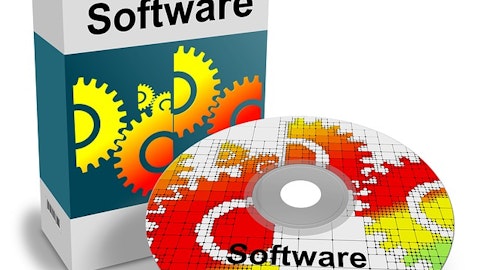Confluent, Inc. (NASDAQ:CFLT) Q4 2023 Earnings Call Transcript February 7, 2024
Confluent, Inc. misses on earnings expectations. Reported EPS is $-0.0003 EPS, expectations were $0.05. Confluent, Inc. isn’t one of the 30 most popular stocks among hedge funds at the end of the third quarter (see the details here).
Shane Xie: Hello, everyone. Welcome to the Confluent Q4 and Fiscal Year 2023 Earnings Conference Call. I’m Shane Xie from Investor Relations, and I’m joined by Jay Kreps, Co-Founder and CEO; and Rohan Sivaram, CFO. During today’s call, management will make forward-looking statements regarding our business, operations, sales strategy, market and product positioning, financial performance and future prospects, including statements regarding our financial guidance for the fiscal first quarter of 2024 and fiscal year 2024. These forward-looking statements are subject to risks and uncertainties, which could cause actual results to differ materially from those anticipated by these statements. Further information on risk factors that could cause actual results to differ is included in our most recent Form 10-Q filed with the SEC.
We assume no obligation to update these statements after today’s call, except as required by law. Unless stated otherwise, certain financial measures used on today’s call are expressed on a non-GAAP basis, and all comparisons are made on a year-over-year basis. We use these non-GAAP financial measures internally to facilitate analysis of financial and business trends and for internal planning and forecasting purposes. These non-GAAP financial measures have limitations and should not be considered in isolation from or as a substitute for financial information prepared in accordance with GAAP. A reconciliation between these GAAP and non-GAAP financial measures is included in our earnings press release and supplemental financials, which can be found on our IR website at investors.confluent.io.

And with that, I’ll hand the call over to Jay.
Jay Kreps: Thanks, Shane. Good afternoon, everyone, and welcome to our fourth quarter earnings call. We closed fiscal year 2023 with a solid Q4, exceeding the high end of our guided metrics. Total revenue grew 26% to $213 million. Confluent Cloud revenue reached $100 million for the first time, growing 46% and non-GAAP operating margin came in at 5.3%, our first positive quarter, improving 27 percentage points. Since going public two and a half years ago, we have more than doubled our total revenue run rate and driven more than 46 percentage points in non-GAAP operating margin improvement. These results are a testament to the power of our platform and the incredible growth of the data streaming category. Last quarter, we discussed our accelerated transition to a fully consumption oriented, go-to-market model for Confluent Cloud, including shifting our sales compensation for cloud to be based on incremental consumption and new logo acquisition, orienting our field team towards landing new customers and driving new workloads with customers and adapting product and pricing to reduce friction in landing customers and maximize the potential for expansion.
As we said before, these changes are internal to our go-to-market teams and don’t change our business model or revenue model or any other customer facing aspect, all of which are already consumption oriented. We’ve executed some of the initial changes of our consumption transformation effective January 1, including a new compensation model and the initial rollout of new systems, metrics and measures. Last week, I spent time with our sales and marketing teams at our sales kickoff. The initial reaction from the team has been very positive. We will be spending the next few quarters fully adapting and optimizing our business to these changes. We believe our transition to a fully consumption oriented business, alongside our category leadership puts us in an excellent position to capture more of the $60 billion data streaming platform opportunity in front of us.
See also 10 Best Cheap Car Insurance in New York for 2024 and 25 Best Colleges with High Acceptance Rates.
Q&A Session
Follow Confluent Inc.
Follow Confluent Inc.
I’d like to spend a few minutes and reflect on the increasing recognition of data streaming as a category and its potential for growth. One way of thinking about data technologies is to break them into two groups; those oriented for handling Data at Rest, the databases and storage systems, and those oriented at handling data in motion. These two areas had very different evolutionary paths. Over the last several decades, Data at Rest has become highly concentrated around a powerful infrastructure platform, the database, a $90 billion plus category. The landscape of Data in Motion technologies remained highly fragmented, with technology analysts recognizing disparate technology categories including message queues, application integration tools, data integration tools, event brokers, ETL products, iPass, and more.
The reason for this was largely technological. Each of these product categories was defined by its technological limits, whether latency, scale, complexity of processing, or ease of use. The potential for data streaming is to collapse the fragmentation of Data in Motion technologies and create a new data platform that supersedes each of these limited precursors. Since Confluent creation, that has been our central thesis that the data streaming platform would be a data platform of similar importance and scale to databases, but acting as the central nervous system handling all the data in motion. Now that this category has gotten to scale in usage, it’s starting to get formal recognition. In December, research published by Forrester validated our thesis that data streaming platforms are a distinct category that has become a mission-critical component of the modern data stack.
The Forester Wave Streaming Data Platforms Q4 2023 recognizes streaming data as the pulse of an enterprise and names Confluent a leader. We were also named a leader in the Forrester Wave Cloud data pipelines Q four 2023 and won InfoWorld’s Technology of the Year in the data management streaming technology category. Taken together, these recognitions show us that the data streaming era is here and Confluent is the clear leader. As we’ve discussed before, this data streaming platform is more than just Kafka. Kafka is the data stream, a foundational layer, but it’s just the start. To extract the full value of data in motion, organizations need to connect to the systems they have, process data in real-time, and govern these flows of data across the enterprise.
Each of these capabilities, connectors, stream processing and governance, is on a path to become a sizable business on their own. One key aspect of our consumption transformation is that it lets our go-to-market directly drive consumption around these additional products, which can be used under the same consumption contract with no additional purchasing friction. Today, I’d like to spend a few minutes covering what’s happening in the world of stream processing. Stream processing enables organizations to act on data as it arrives, rather than waiting to process it in batch at the end of the day. For an airline, it could be processing data from streams of flight times, weather information, and customer information. By itself, these streams are powerful, but with stream processing, these streams can be combined and enriched to drive logistics, pricing, scheduling and cascade that information throughout the system to minimize travel disruptions.
For Confluent this represents a significant growth opportunity. Today the spend on applications around the data stream is significantly higher than on the stream itself. By making these applications easier to build and bringing that spend into our platform, we believe both adoption of our platform as well as the growth of our business will be accelerated. I’d like to spend the next few minutes addressing the question of why Confluent is uniquely positioned to succeed in stream processing with our Flink offering. There are three key reasons I’ll address. First, Flink is the emerging de facto standard. Second, the company with the stream gets the processing and third is the rise of data products. Let me address each of these in turn. The first reason is perhaps the most obvious.
We believe Flink is simply the best technology in this space and has attracted the largest community of developers working with real-time apps. This technological superiority comes from the fact that Flink was designed to have the full processing power of a database, but was designed from the ground up for streaming, addressing batch processing needs as a special case of stream processing. This affects every aspect of the design, from how storage is managed, how failover and fault tolerance works, to the latency of results and the interfaces presented to users. This is dramatically better than attempts to bolt streaming features into existing databases or batch processing engines. The result is our ability to offer the most complete platform and ecosystem for stream processing, one that supports SQL as well as native apps in popular programming languages, and it unifies batch and real-time processing.
This platform has attracted the most vibrant community doing development in this space. The developers have spoken and like Kafka, this is the technology that they choose when they need real time streaming. In 2023, there were nearly 1 million unique downloads of Flink and a 43% increase in open job requisitions for Flink developers. And like Kafka, it has proven itself with one of the most sophisticated user bases, including companies like Apple, Capital One, Netflix, Stripe and Uber. Perhaps what’s most impressive is that Flink has attracted this broad adoption in apex users without having significant commercial backing or go-to-market support. This is truly the best engineers picking the best technology. Our investment in Flink gives us a leadership position in the winning technology in stream processing, but our advantage isn’t limited to the technology or developer community.
As attractive as stream processing is, it doesn’t stand alone. It is always adopted along with a stream of data that needs processing. Everyone agrees that Kafka is the standard for the stream itself. As the leaders in Kafka, we are in a prime position for capturing the emerging stream processing market. Indeed, this pairing is very similar to what made databases themselves successful. Databases brought together data storage with data processing into a unified product, driving a vastly simpler experience. Confluent is working towards the same by unifying data streaming with Kafka with stream processing via Flink. We believe the resulting data streaming platform is exactly the product the customers want. This pairing is not just skin deep, either.
Confluent can make the stream and processing layers work together as a coherent product that is optimized as a single system, from performance to security to data discoverability to transactional semantics. And we think the processing layer that is unified with the underlying stream is going to be the easiest, fastest, and most obvious choice for any developer. That makes Confluent Flink offering a kind of default option when it comes to processing data in Kafka. There’s a final trend that supports Confluent’s position in stream processing, and that is the increasing role of reusable data products in modern data architecture. In classical data architecture, data largely lived in a silo and at most was extracted to a single destination, the data warehouse, where it was processed to clean it up and make it usable for various reporting and analytics use cases.
In modern data architecture, the data warehouse is no longer the single destination for data. Dozens or even hundreds of other systems feed off critical data streams. Repeating the processing that cleans up data for use dozens or hundreds of times is completely infeasible. The result is that the processing is being pulled upstream from the destination to the source to produce high quality, reusable data products. That is, rather than having dozens of destination systems, all try to clean up the data. Instead the source is responsible for publishing data in a processed, ready-to-use format to all destinations. This means the processing is happening on the stream as data enters the system rather than in the destination, and this is pulling workloads from batch processing in the destinations into stream processing at the source.
This is why, structurally, we expect the bulk of stream processing won’t happen in destination systems like databases, data warehouses, or data lakes. We think these three reasons are each powerful enough to draw processing workloads into the data streaming platform and put together will make the DSP the nexus of NextGen data workloads. We continue to see demand from customers who are building the next wave of generative AI applications, including AI powered procurement software, chatbots, coding platforms, and even unexpected use cases like predicting and detecting cavities. These organizations turn to Confluent to quickly build and scale gen AI applications that connect their proprietary systems to LLMs so they can deliver trustworthy and contextually rich insights to their customers.





